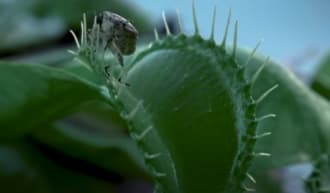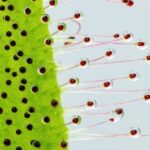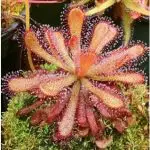As an Amazon Associate, this site earns commissions from qualifying purchases. For more details, click here.
Venus flytraps (Dionaea muscipula) are iconic carnivorous plants known for their unique ability to trap and digest insects. While their carnivorous nature is fascinating in itself, what adds to their allure is the wide array of varieties and cultivars available to plant enthusiasts. From classic cultivars to newer hybrids, Venus flytraps offer a captivating diversity that continues to intrigue botanists and hobbyists alike.
Classic Venus Flytrap Varieties
“Typical”: The standard Venus flytrap variety, characterized by its green traps with red interiors and cilia-lined lobes. It’s the quintessential representation of the species and is widely cherished for its classic appeal.
“Akai Ryu” (Red Dragon): This variety boasts deep red traps, adding a dramatic flair to the plant. The vibrant coloration is a result of increased anthocyanin pigments, often intensified by exposure to bright light.
Unique Venus Flytrap Cultivars
“Dente”: Known for its serrated trap edges, giving it a tooth-like appearance, hence the name “Dente,” which means “tooth” in Italian. This cultivar adds an intriguing texture to the typical Venus flytrap traps.
“Clayton’s Red Sunset”: Renowned for its intense red coloration, especially during the warmer months or under high light conditions. The traps of this variety can turn almost entirely red, making it a striking addition to any collection.
Giant Venus Flytraps
“Big Mouth”: As the name suggests, this variety features larger-than-average traps, making it a favorite among enthusiasts seeking impressive size. With traps that can grow up to twice the size of standard varieties, “Big Mouth” commands attention.
“King Henry”: Another giant among Venus flytraps, “King Henry” is revered for its robust growth and oversized traps. This variety exemplifies the potential of Venus flytraps to reach impressive dimensions when provided with optimal growing conditions.
Venus Flytrap Hybrids and Exotics
“Dionaea muscipula ‘G14′”: A recent hybrid that combines traits from various Venus flytrap varieties, resulting in unique features such as larger traps with red coloration and distinct patterning. This hybrid showcases the endless possibilities for breeding new and exciting Venus flytrap cultivars.
“Dionaea muscipula ‘B52′”: Named after the legendary B-52 bomber aircraft for its formidable size and trapping prowess, this hybrid is prized for its robust growth and large traps, making it a sought-after addition to collections worldwide.
Variegated Varieties
“Dionaea muscipula ‘Coquillage'”: Characterized by its variegated traps, which display patches of light green and white, creating a marbled effect. This variety adds a unique aesthetic appeal to Venus flytrap collections, standing out among other cultivars.
“Dionaea muscipula ‘Jaws’: This cultivar is distinguished by its irregularly shaped traps, which often resemble gaping jaws. The traps may display variegation, adding to the striking appearance of this variety.
Miniature Varieties:
“Dionaea muscipula ‘Microdent'”: A miniature Venus flytrap variety with tiny traps, making it ideal for terrariums or small growing spaces. Despite its diminutive size, “Microdent” retains all the captivating features of its larger counterparts.
“Dionaea muscipula ‘G14’ Compact”: A compact version of the ‘G14’ hybrid, featuring smaller traps and a more condensed growth habit. This variety is perfect for growers who prefer smaller plants or limited space.
What Venus Flytrap Varieties are Best for Beginners?
Choosing the right Venus flytrap variety for beginners is crucial for ensuring a successful and enjoyable experience with these fascinating plants. While all Venus flytraps require similar care, some varieties may be more forgiving or easier to grow for those new to carnivorous plants. Here are some Venus flytrap varieties that are well-suited for beginners:

Typical
As the standard Venus flytrap variety, “Typical” is an excellent choice for beginners due to its hardiness and adaptability. It’s widely available, making it easy to find at garden centers or online retailers. “Typical” requires the same care as other Venus flytrap varieties and is an ideal starting point for learning about carnivorous plants.
Related. Should You Feed Venus Flytraps?
“Akai Ryu” (Red Dragon)
Despite its striking appearance with deep red traps, “Akai Ryu” is relatively easy to grow, making it suitable for beginners. Its vibrant coloration adds visual interest to any collection, while its care requirements remain similar to those of the standard Venus flytrap. With proper care, “Akai Ryu” can thrive and flourish in a beginner’s care.
“Dente”
While “Dente” may have serrated trap edges, it is still a resilient variety that can tolerate beginner mistakes. Its unique appearance adds intrigue to the collection, and its care requirements are not significantly different from those of other Venus flytrap varieties. Beginners can enjoy the added visual appeal of “Dente” while honing their skills in carnivorous plant care.
“Microdent”
As a miniature Venus flytrap variety, “Microdent” is well-suited for beginners with limited space or those interested in terrarium gardening. Despite its small size, “Microdent” retains all the captivating features of larger Venus flytrap varieties and is relatively forgiving of beginner errors. Its compact nature makes it an excellent choice for beginners looking to start small.
“G14 Compact”
This compact version of the ‘G14’ hybrid offers all the benefits of its larger counterpart in a more manageable size. “G14 Compact” is suitable for beginners who prefer smaller plants or have limited space for cultivation. Its compact growth habit makes it easier to care for while still providing the unique characteristics of the ‘G14’ hybrid.
These Venus flytrap varieties offer beginners an opportunity to explore the world of carnivorous plants with confidence. With proper care and attention, these varieties can thrive and provide endless fascination for growers at any skill level. As beginners gain experience and confidence in cultivating Venus flytraps, they may choose to explore other varieties and hybrids to expand their collection further.
How Many Venus Flytrap Varieties are There?
There are numerous cultivated varieties and hybrids of Venus flytraps (Dionaea muscipula) available to plant enthusiasts. While the exact number may vary depending on breeding efforts and new introductions, there are likely hundreds of recognized varieties and hybrids. These varieties can differ in characteristics such as trap color, size, shape, and patterning.
Botanical gardens, nurseries specializing in carnivorous plants, and online retailers often offer a wide selection of Venus flytrap cultivars, ranging from classic varieties to novel hybrids developed through breeding programs. Each variety may have its own unique traits and characteristics, contributing to the diverse and fascinating world of Venus flytrap cultivation.
Additionally, enthusiasts and hobbyists may continue to develop new cultivars through selective breeding, further expanding the variety of Venus flytraps available to growers. With ongoing research and experimentation, the number of recognized Venus flytrap varieties is likely to continue growing, offering endless possibilities for collectors and enthusiasts alike.
Beginners Guide to Venus Flytrap Care
Caring for Venus flytraps (Dionaea muscipula) can be an exciting and rewarding experience, especially for beginners delving into the world of carnivorous plants. While these unique plants have specific care requirements, they can thrive with proper attention and a basic understanding of their needs. Here’s a beginner’s guide to caring for Venus flytraps:
Light
- Venus flytraps require ample sunlight to thrive. Place your plant in a location where it can receive at least 6 hours of direct sunlight each day, such as a south-facing windowsill or outdoors in a sunny spot.
- If growing indoors, supplement natural light with a grow light to ensure adequate brightness, especially during the winter months when sunlight may be limited.
Water
- Use only distilled water, rainwater, or purified water to water your Venus flytrap. Tap water may contain minerals and chemicals that can harm the plant over time.
- Keep the soil consistently moist, but not waterlogged. Allow the soil to dry slightly between waterings, then water thoroughly until water drains from the bottom of the pot.
- Avoid watering with water that contains salts or minerals, as these can build up in the soil and harm the plant.
Soil
- Plant Venus flytraps in a well-draining, acidic soil mix. A mixture of sphagnum moss and perlite or sand works well.
- Avoid using potting soils or fertilizers, as these can harm Venus flytraps due to their low nutrient requirements.
Humidity
- Venus flytraps prefer high humidity levels, similar to their natural habitat in boggy areas. You can increase humidity by placing the plant on a humidity tray filled with water or by misting the plant regularly.
- Avoid placing the plant near heating or cooling vents, as this can reduce humidity levels.
Temperature
- Venus flytraps grow best in temperatures between 70°F to 90°F (21°C to 32°C) during the day and slightly cooler temperatures at night.
- Protect Venus flytraps from extreme heat or cold, as they are sensitive to temperature fluctuations. Avoid placing them near drafty windows or doors.
Feeding
- While Venus flytraps can catch insects on their own, they may benefit from occasional feeding, especially if grown indoors.
- Feed Venus flytraps small live insects such as flies, ants, or crickets. Avoid feeding them meat or human food.
- Only feed mature traps that are fully open and functional, as closed traps cannot digest prey.
Dormancy
Venus flytraps require a period of dormancy during the winter months to rest and conserve energy.
During dormancy, reduce watering and place the plant in a cooler location with reduced light, such as an unheated garage or basement.
Resume normal care in spring when new growth emerges.
Pruning
- Trim away dead or blackened leaves with clean scissors to maintain the plant’s appearance and prevent mold or fungal growth.
- Avoid triggering traps unnecessarily, as each trap can only open and close a limited number of times before dying.
By following these basic care guidelines, beginners can enjoy growing and caring for Venus flytraps with confidence. With proper attention to light, water, soil, and other factors, these captivating carnivorous plants can thrive and provide endless fascination for plant enthusiasts of all ages.
Conclusion
The world of Venus flytrap varieties is as diverse as it is captivating. From classic cultivars to novel hybrids, each variety offers its own unique charm and appeal.
Whether you’re drawn to the dramatic red hues of “Akai Ryu” or the impressive size of “Big Mouth,” there’s a Venus flytrap variety to suit every taste and preference. As breeding efforts continue and new cultivars emerge, the fascination with these carnivorous plants shows no signs of waning, ensuring that there will always be something new and exciting to discover in the world of Venus flytraps.

My fascination with carnivorous plants began many, many years ago with Venus Fly Traps. Now I am more than happy to impart what I know with other enthusiasts and those who are curious about meat eating plants.


